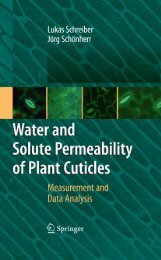Topics in Current Chemistry
Topics in Current Chemistry
Topics in Current Chemistry
You also want an ePaper? Increase the reach of your titles
YUMPU automatically turns print PDFs into web optimized ePapers that Google loves.
Electronic Spectroscopy and Photoreactivity of Transition Metal Complexes 131<br />
2.4.3<br />
Cluster Expansion Methods<br />
The cluster expansion methods are based on an excitation operator which<br />
transforms an approximate wave function <strong>in</strong>to the exact one accord<strong>in</strong>g to<br />
the exponential ansatz<br />
Y ¼ expðTÞji 0<br />
ð2Þ<br />
where T is a sum of s<strong>in</strong>gle- to N-particles excitation operators (Coupled-<br />
Cluster theory) [75–77] or of symmetry adapted s<strong>in</strong>gle- to N-particles excitation<br />
operators (Symmetry Adapted Cluster theory) [78]. The simplest<br />
truncation of T is to the 2nd Order where the s<strong>in</strong>gle and double excitations<br />
are <strong>in</strong>cluded <strong>in</strong> the cluster expansion (CCSD [79] or SAC) based on the HF<br />
s<strong>in</strong>gle determ<strong>in</strong>ant j0i. When electron correlation effects are dom<strong>in</strong>ated by<br />
pair effects these methods recover 90–95% of the exact correlation energy if<br />
the wave function is described by a dom<strong>in</strong>ant closed-shell determ<strong>in</strong>ant. The<br />
rema<strong>in</strong><strong>in</strong>g correlation effects due to higher excitations are estimated by approximate<br />
methods like <strong>in</strong> the CCSD(T) approach [80] where the triple excitations<br />
are <strong>in</strong>cluded perturbationally. These methods based on a separated<br />
electronic pairs approach <strong>in</strong> which pair clusters are used to describe the correlation<br />
between two electrons are size-extensive by def<strong>in</strong>ition and <strong>in</strong>dependent<br />
on the choice of reference orbitals. However, these methods which converge<br />
efficiently are hardly generalized to multi-reference start<strong>in</strong>g wave<br />
functions. As far as the excited states and associated properties are concerned<br />
two cluster expansion based methods developed orig<strong>in</strong>ally for openshell<br />
situations have been proposed. The first one so-called SAC-CI method<br />
[56–58] supposes that the major part of electron correlation <strong>in</strong> the closedshell<br />
ground state is transferable to the excited states s<strong>in</strong>ce the excitation of<br />
<strong>in</strong>terest <strong>in</strong>volves only one and/or two electrons. These transferable dynamical<br />
correlation effects are expressed through an exponential operator and a<br />
l<strong>in</strong>ear operator is used to represent the non-transferable state-specific correlation<br />
effects such as quasi-degeneracy s. The absorption spectrum of TiCl 4<br />
has been re<strong>in</strong>vestigated on the basis of this method lead<strong>in</strong>g to a perfect<br />
agreement with experimental data and a new assignment with an accuracy<br />
of the order of 0.15 eV [81]. In the CC based methods, so-called equation-ofmotion<br />
CCSD (EOM-CCSD) [51–55] ionisation potentials, electron aff<strong>in</strong>ities<br />
and excitation energies are obta<strong>in</strong>ed directly from the equation of motion<br />
operat<strong>in</strong>g on the ground state wave function. This approach characterized<br />
by an unambiguous treatment of excited states where the only choices are<br />
the atomic basis sets and the excitation level of the operators is very demand<strong>in</strong>g<br />
computationally and has been applied to only one transition metal<br />
complex, namely FeCl 4 Ÿ lead<strong>in</strong>g to promis<strong>in</strong>g results for charge transfer<br />
transitions from the 6 A 1 ground state [82]. A recent workable extension socalled<br />
extended similarity transformed EOM-CCSD (extended-STEOM-CC)







